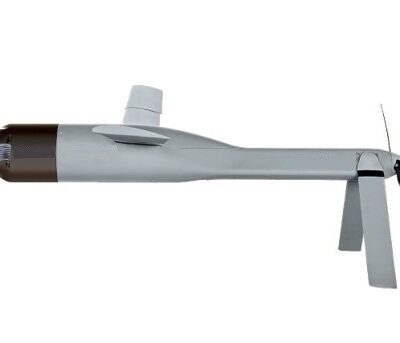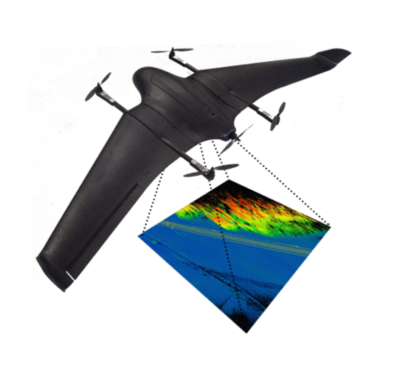Manned-unmanned teaming can serve as a force multiplier, with collaboration between the government and industry key to moving it forward.
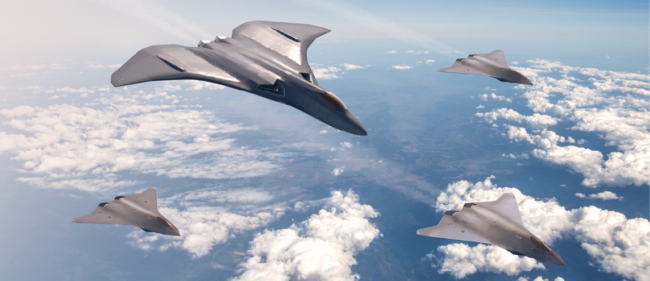
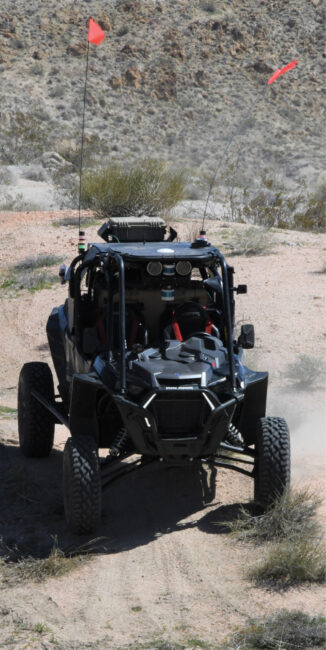
As Maj. Cory Wallace puts it, no one is going to cry if a robot doesn’t make it home.
Putting robots out in front of warfighters creates a standoff distance that could be the difference between going home and not. Unmanned systems can provide critical information regarding the enemy’s location or carry out a strike while the crewed aircraft or ground vehicle stays back. They can expand capabilities, serve as loyal wingmen and help our militaries match up better to the adversary, becoming true force multipliers when they work in tandem with their crewed counterparts.
“If anything, future battlefields are going to get more lethal and more hyperactive, so the ability to offload tactical risk onto a robot is something we absolutely need to maintain combat power,” said Wallace, the U.S. Army’s remote combat vehicle (RCV) requirements lead for the Next Generation Combat Vehicle Cross Functional Team. “They expand the geometry of the battlefield and enable leaders to make informed decisions faster than the adversary, accelerating their decision cycle to a pace they can’t keep up with.”
Truly leveraging this capability has become a focus of the Department of Defense (DOD), with the budget for acquiring and testing unmanned systems increasing every year. The various military branches are beginning to home in on the capabilities they’d like these solutions to have, said Steven Fendley, president of Kratos’ Unmanned Systems Division, giving industry a better idea of how to meet their needs. Missionization has become a focus for UAS, as has compatibility with other systems in the battlespace.
There’s also a focus on quantities, and just how many unmanned aircraft it will take to truly be effective, Fendley said. While one-to-one provides that standoff distance, it isn’t nearly as powerful as a group of platforms. The multiplication factor plays a significant role, with the unmanned systems becoming an extension of the crewed system, offering much greater capabilities.
In fact, U.S. Air Force Secretary Frank Kendall recently announced a plan to field 200 Next-Generation Air Dominance aircraft (NGAT) and 1,000 Collaborative Combat Aircraft (CAA) to go along with them. As many as five CCAs could collaborate with each crewed aircraft for various missions. These systems will be more cost effective than crewed aircraft, providing the affordable mass that’s needed.
There’s now a sense of urgency to obtain air superiority, making the testing unfolding and the partnerships developing critical, particularly when it comes to UAS.
“The biggest thing is knowing the fight is going to be in a highly contested environment,” Brig Gen Dale R. White, Air Force Program Executive Officer for Fighters and Advanced Aircraft, said during a Mitchell Institute for Aerospace Studies panel discussion. “We talk about this in very platform-centric ways. If you take a step back and look at the operational imperatives, it is typically that road map that says hey, this is what we’re going to have to do to be effective in a highly contested environment. We’ve dissected that in many ways and you can see we recognize the threat has changed, we recognize where technology is at and what the art of the possible is, and we’re ready to move out and get that capability.”
Scaling up unmanned systems and teaming them with manned platforms also helps overcome the current mismatch, Fendley said. When we look at our peer adversaries, “their numbers are staggering,” and the “budget realities for the U.S. doesn’t allow us to have tens of thousands of crewed aircraft.” And even if it did, we wouldn’t be willing to risk that many human lives.
To successfully integrate unmanned aircraft into such missions, it’s going to require collaboration between industry, government and militaries.
“Just like we are seeing in the commercial industry, there’s a need to have a standard system that can be more easily modified for various missions while also allowing it to be upgraded over time,” said Tim Frei, sector vice president, research & advanced design for Northrop Grumman. “This means that we would have a core system that operates autonomously while connecting seamlessly with manned aircraft. Autonomous control has advanced to the point where a single human operator can control numerous uncrewed systems. If we were to outfit those uncrewed systems with different capabilities, operational commanders would have many more options at their disposal.”
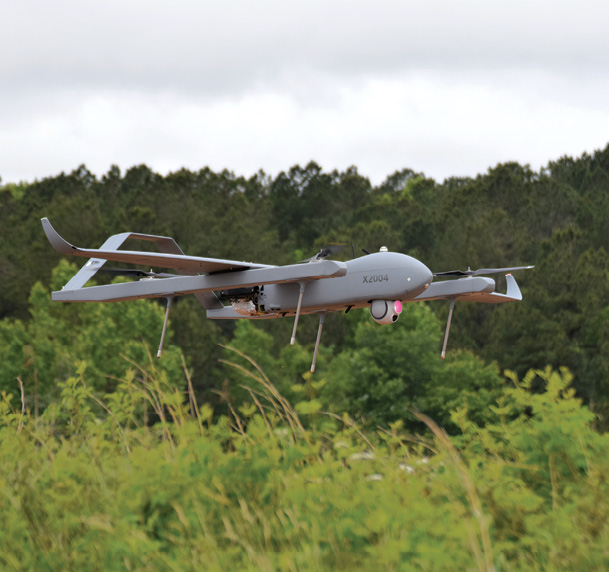
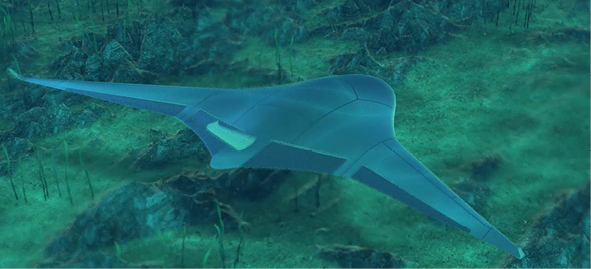
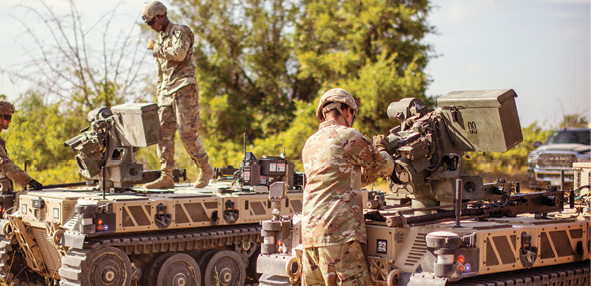
Photos courtesy Textron Systems, DARPA and U.S. Army.
WORKING TOGETHER
In the last year, there’s been an effort toward fielding unmanned systems across the military branches, said David Adamiak, business development manager for BAE Systems. There’s now more operational testing and a focus on putting the systems in the hands of warfighters to give them the ability to evaluate the technology, and in some instances, leverage it.
The key to all this is taking the modular open systems approach (MOSA), said Wayne Prender, senior vice president for air systems at Textron Systems. This will give militaries the ability to swap out payloads and modules as needed, regardless of the platform they’re using. That open architecture concept is what will allow these systems to work together, and will require collaboration from defense customers, industry and academia.
Managing the complexity these systems bring is one of the main challenges to overcome, said Don “BD” Gaddis, vice president of business development for Boeing Defense. Every time another unmanned system with different data links, networks and waveforms is added, it increases complexity exponentially. This makes the modular open system concept key.
“You have to manage complexity or manned-unmanned teaming won’t scale,” he said. “I think we’re on the path to do that. You have to adhere to government-owned frameworks, standards and interfaces.”
Over the past five years, he’s seen the U.S. Army, Marines, Navy, Air Force and Coast Guard begin to migrate toward universal command and control interfaces and open communication standards. Adhering to government-owned standards, having the ability to integrate different frameworks and incorporating third party applications into these systems will decrease the cost and increase interoperability. Platform architectures need to be open as we move away from vendor lock.
Boeing demonstrated this last year. A third-party intelligence, surveillance and reconnaissance (ISR) search pattern was integrated into the MQ-25, which has an architecture based on the government-owned Open Mission System specification. Northrop Grumman’s E-2D Advanced Hawkeye command and control aircraft, Boeing’s P-8A Poseidon maritime patrol and reconnaissance aircraft and Boeing’s F/A-18 Block III Super Hornet fighter jet tasked four virtual MQ-25s to conduct ISR missions.

With the parameters given, the MQ-25 ran constraint checks before successfully performing the missions. The virtual demonstration showed how other aircraft can use MQ-25’s architecture and task it to conduct tanking and ISR missions when the ship-based ground control station is comms out.
“You can integrate other services like communications relay, or a targeting service or a radar,” Gaddis said. “The idea is to reduce the cost of that integration and reduce complexity. That’s the make-or-break point for any manned-unmanned teaming.”
BAE Systems is continually building out its open mission capability to align with the standard the government is driving toward, Adamiak said. The company’s software development kit is an example. Its open architecture features manned-unmanned teaming algorithms, designed to be adaptable to new missions and open to future technologies. It has the flexibility to move from one platform to another, delivering the same capabilities and effectiveness.
The other critical piece, he said, is the validation of that openness. There has to be more third-party testing to give customers and industry partners assurance a system is truly open and can be improved not just from within, but externally as well. This perspective helps build that industry collaboration piece, which, while a new way of thinking, is critical to moving forward.
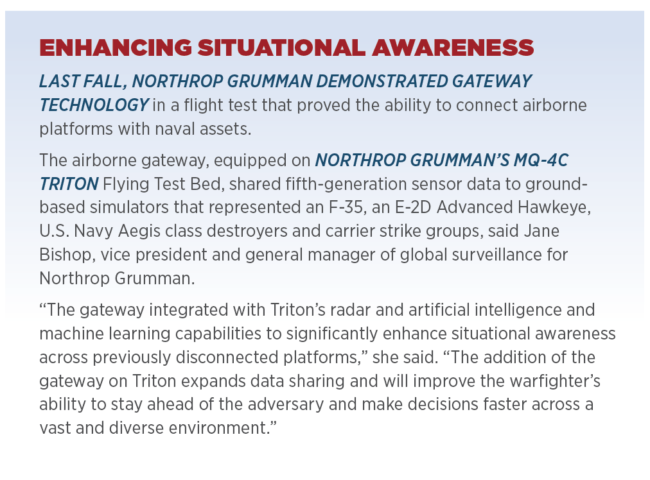
Then there’s integration. The technology is pretty solid, Fendley said, but determining the best way to integrate a large number of collaborative unmanned aircraft with current military operations isn’t easy. And that, again, will require collaboration.
“If a mission is four crewed aircraft now, that’s plus 20 uncrewed aircraft so there’s 24 aircraft operating together in an area on a mission where it used to be four,” Fendley said. “That’s a substantially more complex equation. And ultimately, there’s the human element and making sure the four crewed aircraft are safe the entire time. That part is incredibly challenging and is the reason we don’t have thousands of uncrewed aircraft operating today with our manned aircraft.”
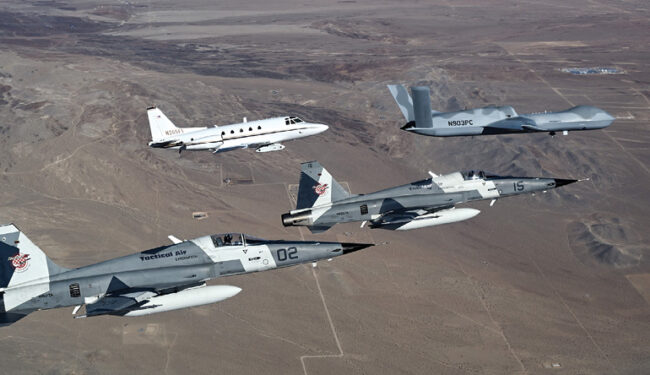
THE APPLICATIONS
We’re moving toward a future where most air combat missions will involve some degree of manned-unmanned teaming, said C. Mark Brinkley, a spokesman for General Atomics Aeronautical Systems Inc. (GA-ASI). The technology is advancing rapidly, and that will only continue as new procedures, tactics and techniques are developed.
For fighters, he said, manned-unmanned teaming with autonomous unmanned combat air vehicles (UCAVs) is among emerging cases, with the systems requiring simpler interfaces than traditional UAS. Instead of hands-on piloting, an autonomous UCAV is commanded through task-based commands to an AI pilot, possibly issued from a fighter pilot or another support operator.
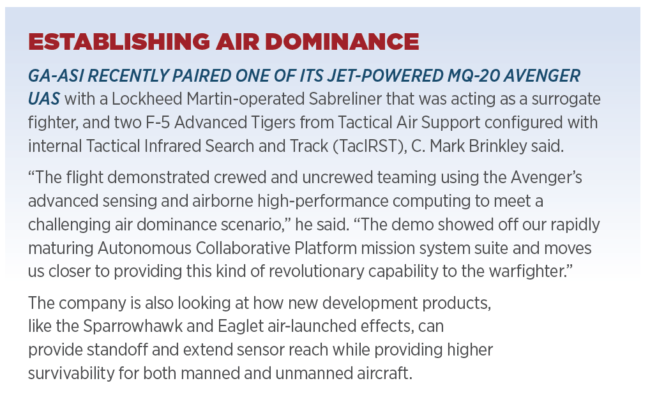
“These UCAVs will augment the fighter and provide force multiplication for hostile engagements,” Brinkley said. “The simpler interface allows an already task-saturated team in a crewed platform to direct an autonomous UAS to augment their mission.”
Unmanned systems also can be teamed with attack helicopters. GA-ASI’s Gray Eagle 25M, for example, might deploy a smaller, air-launched effect such as Eaglet to fly forward and conduct surveillance or targeting missions, Brinkley said. An Apache helicopter pilot on the mission could assume control of the Eaglet to direct it for specific missions to support the next phase of the battle. From there, the Apache could return control of the Eaglet to the 25M operator for its next set of tasks.
Fendley sees two main applications. In the first, the unmanned system is an extension of the crewed aircraft, expanding its weapon or reconnaissance capability. The second scenario involves a group of unmanned systems working together to execute a specific mission, especially those you’d be hesitant to have a crewed system take on. Because the systems won’t be exquisite, it will also be cost effective to deploy them more often.
Offensive counter air is the mission type that catches everyone’s attention, Gaddis said, but the “warfighter imagination is the only limitation.” The possibilities span across domains and even joint missions.
Unmanned systems also can act as comms relays or gateways, Fendley said.
“The capability has broad applications across many different mission sets,” Adamiak said. “Speed and accuracy are strengths that machines have over humans, so when a mission requires speed or accuracy in solving a tactical problem, that’s where uncrewed teammates should be able to deliver enhanced capability and provide a tactical advantage.”
Until autonomy is matured to the point where unmanned systems can keep pace with human counterparts, Wallace sees teaming mainly used in defensive scenarios. That might mean making first contact with a robot, or stationing a robot on a hill to surveil a specific area or to identify the enemy, and then send that information to decision makers.
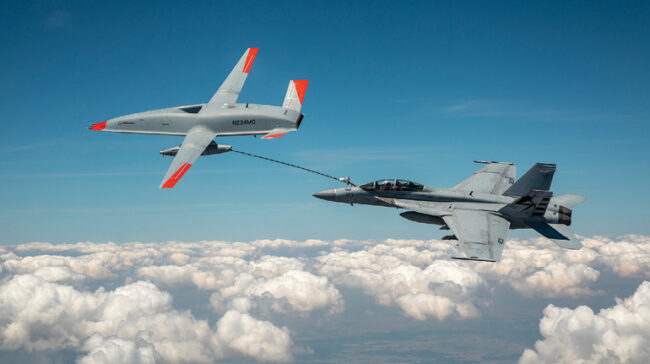
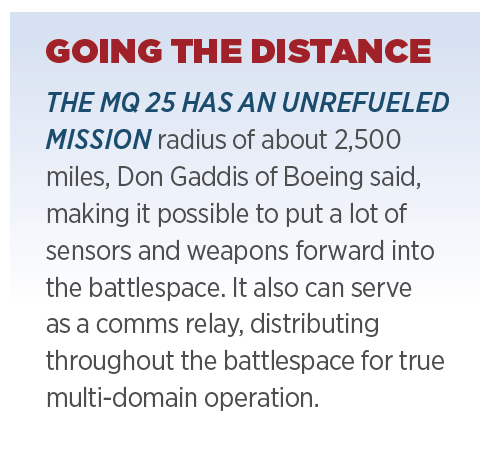
Manned-unmanned teaming can be leveraged across multiple domains and vehicle types, Prender said. Textron’s Shadow already can interoperate with Apache aircraft, with the manned platform able to take over the aircraft’s payload and also communicate with it. Now they’re starting to demonstrate that capability with unmanned ground vehicles through its Aerosonde platform. In a recent demo, the manned aircraft was able to identify nonvisual targets of interest and pass that to the unmanned ground vehicle. It also provided a precise GPS location to a human mounted entity in an environment where that information was otherwise unavailable.
The comms path has to be agnostic for this to work, Gaddis said, so it’s easy for a crewed aircraft, for example, to hand the unmanned systems over to a ship to take on a new task. If the unmanned system has an open architecture and is set up on an agnostic network in the platform, achieving this becomes much easier.
The transition from one domain to another must be seamless from a comms perspective, Adamiak said, and that’s a challenge.
“The movement into multi-domain and multi-vehicle teaming has really been empowered by improved communication,” Prender said. “As we continue to extend from one data link point into mesh networks, the capability where we have multi-in and multi-out data link services and autonomy continues to provide reduced cognitive load for the operators of uncrewed systems that allow those assets to act on their own with less supervision, allowing more assets to operate together.”
THE TECH
Advancements in autonomous control and networking capabilities are critical to manned-unmanned teaming, Frei said, requiring systems to have that modular, open mission design from the start.
In the last few years, the focus has shifted from AI to mission autonomy, Fendely said. The systems may fly a specific mission, for example, until they detect something that will cause them to perform an action, which could be sending data back to the network, executing a terminal maneuver or flying back to home base and then transmitting or downloading data. With true AI, systems would determine what to do on their own, making decisions based on their learning. The problem with that model is the manned aircraft can’t predict what the system will do in any given scenario—making it difficult to work collaboratively.
“Anything that’s unexpected, even if it’s right, is bad for the crewed system,” he said. “You need to know what your wingman is doing.”
BAE Systems is also focusing on mission autonomy, Adamiak said. Flights likely will have an unmanned section lead, with the crewed platform functioning more like a coach calling plays. The unmanned team lead will determine how to solve tactical problems, with the human operator having the ability to step in at any time.
Solving the foundational capabilities first will enable the skills needed for teaming, and that’s what Project Manager Stuart Young is working on through DARPA’s Aircrew Labor In-Cockpit Automation System (ALIAS) and Robotic Autonomy in Complex Environments with Resiliency (RACER) programs.
The focus of the ALIAS program is to reduce the cognitive burden on pilots by taking care of the low-level functions of flying, Young said. If the pilot is in a degraded environment and doesn’t see an obstacle, for example, the aircraft can help. This allows pilots to focus more on the mission, and in the case of manned-unmanned teaming, that means commanding their wingmen at a higher level of abstraction. RACER focuses on developing autonomy algorithms that enable unmanned ground vehicles (UGVs) to maneuver on off-road terrain at higher speeds.
The biggest advancement in RCVs is the user interface, Wallace said, which is absolutely crucial. Everything the RCV can do is encapsulated in that screen, and provides the ability to disseminate information to leaders throughout the battlefield to accelerate decision-making.
Regardless of whether you’re talking about a RCV or a UAS, a robot is a system of systems that needs various technology components, including the software, the controller, the chassis, the payload and the network—with the network being the most critical, Wallace said, at least until autonomy matures.
The data pipelined from the robot to the operator must maintain minimum lag time and be resilient to interference from the enemy, he said, even if that means switching from full motion video to sending periodic bursts of information. Secure, resilient comms is critical.
As the technology continues to advance, the challenge becomes enabling these unmanned systems to truly operate to their full capability, Prender said. The tactics, procedures and CONOPs must be developed, but beyond that, the warfighters relying on the technology must trust it.
That trust will come over time, Young said, as the robots prove they can do what’s expected.
“This is a multi-layered problem but it boils down to trust, and that’s probably the limiting factor,” Prender said. “Both defense and industry are striving to build that trust and that’s where you see the high-level experimentation and collaboration.”
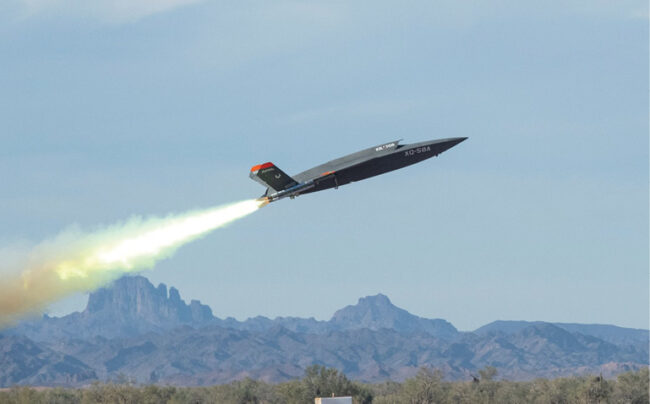
MOVING FORWARD
Manned-unmanned teaming isn’t just a vision for the future, it’s imperative, Adamiak said, and requires support and leadership from within the DOD, funding, congressional support and for industry to openly collaborate. That’s unfolding now.
“It’s in acceleration mode, where there’s going to be more and more integration and testing,” he said. “We’re moving from experimentation to putting the technology in the hands of the user community.”
Gaddis agrees the pace will start to accelerate, noting some unmanned aircraft, like the MQ-25, already meet teaming requirements. But everything on these systems will require autonomy. That’s the critical piece to “changing the game anywhere in the world, but especially in the Pacific.”
What’s happening in Eastern Europe has informed not just the defense customer but the world about just how effective unmanned systems can be in battle, Prender said, as well as what vulnerabilities and challenges exist. We’re going to see more optimized unmanned platforms designed for specific uses and to operate in specific parts of the world, which will “allow these platforms to blossom.” And the technology developed for manned-unmanned teaming will be leveraged in crewed mission sets as well.
“If you can use the automaton unlocked by uncrewed systems to supplement the crew, you can reduce the manpower needed to operate a system,” he said. “In an environment where military recruitment and retention is becoming a problem, unlocking that becomes an enabler.”
To match up to the adversary, it’s going to take deploying thousands, if not tens of thousands, of highly capable, yet affordable aircraft, Fendley said. Exquisite aircraft will be reserved for manned systems, making it more economical to deploy UAS at scale.
“The killer is going to be if the requirements are so challenging the systems become unaffordable, and we get to the point that we can’t achieve the goal. Not even the goal, the need,” Fendley said. “The need is to line up with our peer adversaries, who have many more systems than we have today. Developing and deploying these systems at an affordable cost so there can be many of them and doing so in a rapid fashion so we can quickly catch up to the mismatch is critical.”



